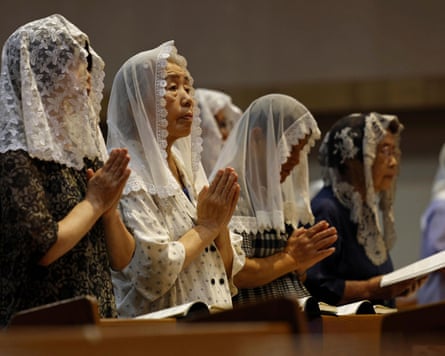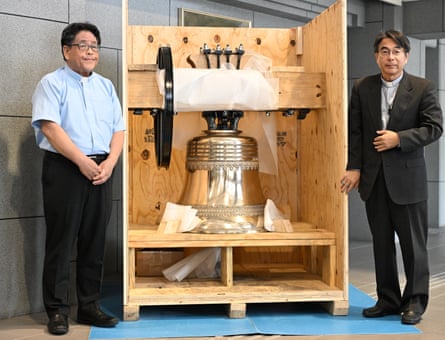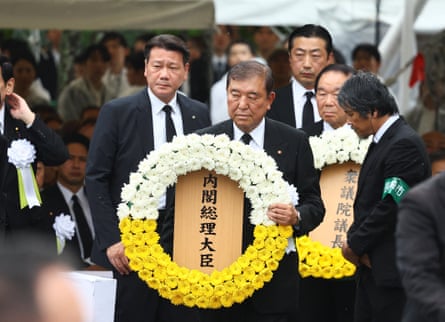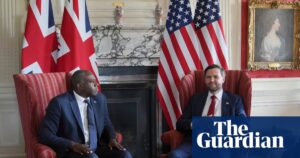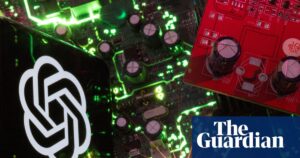Twin cathedral bells rang in unison in Nagasaki for the first time in 80 years on Saturday, commemorating the moment the city was destroyed by an American atomic bomb.
The two bells rang out at Immaculate Conception cathedral, also called the Urakami cathedral, at 11.02am, the moment the bomb was dropped on 9 August 1945, three days after a nuclear attack on Hiroshima.
The imposing redbrick building, with its twin bell towers atop a hill, was rebuilt in 1959 after it was almost completely destroyed in the monstrous explosion just a few hundred metres away. Only one of its two bells was recovered from the rubble, leaving the northern tower silent. With funds from US churchgoers, a new bell was constructed and restored to the tower.
After heavy downpours on Saturday morning, the rain stopped shortly before a moment of silence and ceremony in which Nagasaki mayor Shiro Suzuki urged the world to “stop armed conflicts immediately”.
“Eighty years have passed, and who could have imagined that the world would become like this?” he said. “A crisis that could threaten the survival of humanity, such as a nuclear war, is looming over each and every one of us living on this planet.”
About 74,000 people were killed in the south-western port city, on top of the 140,000 killed in Hiroshima.
Days later, on 15 August 1945, Japan surrendered, marking the end of the second world war.
Historians have debated whether the bombings ultimately saved lives by bringing an end to the conflict and averting a ground invasion. But those calculations meant little to survivors, known as hibakusha, many of whom battled decades of physical and psychological trauma, as well as stigma.
Hiroshi Nishioka, a 93-year-old survivor who was just three kilometres from where the bomb exploded, told ceremony attenders of the horror he witnessed as a young teenager.
“Even the lucky ones [who were not severely injured] gradually began to bleed from their gums and lose their hair, and one after another they died,” he recalled. “Even though the war was over, the atomic bomb brought invisible terror.”
Nagasaki resident Atsuko Higuchi said it “made her happy” that everyone would remember the city’s victims.
“Instead of thinking that these events belong to the past, we must remember that these are real events that took place,” the 50-year-old said.
The chief priest of Urakami Cathedral, Kenichi Yamamura, said the bell’s restoration “shows the greatness of humanity”.
“It’s not about forgetting the wounds of the past but recognising them and taking action to repair and rebuild, and in doing so, working together for peace,” Yamamura said.
He also sees the chimes as a message to the world, shaken by multiple conflicts and caught in a frantic new arms race.
“We should not respond to violence with violence, but rather demonstrate through our way of living, praying, how senseless it is to take another’s life,” he said.
Nearly 100 countries were set to participate in this year’s commemorations, including Russia, which has not been invited since its 2022 invasion of Ukraine. Israel, whose ambassador was not invited last year over the war in Gaza, was in attendance.
An American university professor, whose grandfather participated in the Manhattan Project, which developed the first nuclear weapons, spearheaded the bell project.
During his research in Nagasaki, a Japanese Christian told him he would like to hear the two bells of the cathedral ring together in his lifetime.
Inspired by the idea, James Nolan, a sociology professor at Williams College in Massachusetts, embarked on a year-long series of lectures about the atomic bomb across the United States, primarily in churches. He managed to raise $125,000 from American Catholics to fund the new bell.
When it was unveiled in Nagasaki in the spring, “the reactions were magnificent. There were people literally in tears”, said Nolan.


